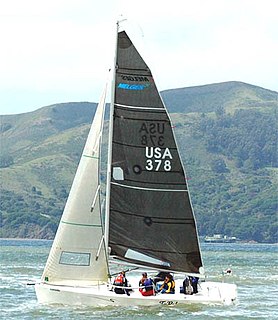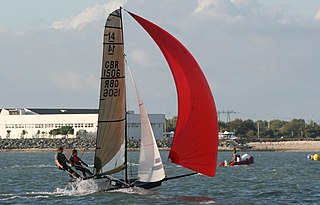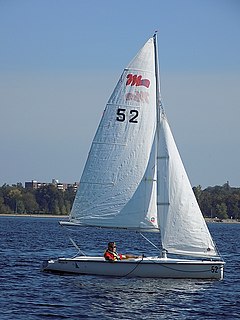
The GP14 is a popular sailing dinghy, with well over 14,000 built.

The Wayfarer is a wooden or fibreglass hulled fractional Bermuda rigged sailing dinghy of great versatility; used for short 'day boat' trips, longer cruises and for racing. Over 11,000 have been produced as of 2016.

A Bermuda rig, Bermudian rig, or Marconi rig is a configuration of mast and rigging for a type of sailboat and is the typical configuration for most modern sailboats. This configuration was developed in Bermuda in the 17th century; the term Marconi, a reference to the inventor of the radio, Guglielmo Marconi, became associated with this configuration in the early 20th century because the wires that stabilize the mast of a Bermuda rig reminded observers of the wires on early radio masts.

The Melges 24 is a one-design class of sailboat commonly used for racing. The monohull sportsboat is notable for its ability to plane over the water downwind in modest winds, and for its combination of a simple design that is highly tunable.

The Hobie Cat is a small sailing catamaran manufactured by the Hobie Cat Company. Hobie's line of products ranges from surfboards to catamaran sailboats to kayaks and stand-up paddle boards, though the Hobie Cat Company is most famous around the world for its catamarans. Hobie also designed a very successful monohull, the Hobie 33.
Taipan Catamarans are sailing catamarans, available amateur built or manufactured by Australian High Performance Catamarans (AHPC).

The 18 ft Skiff is considered the fastest class of sailing skiffs. The class has a long history beginning with races on Sydney Harbour, Australia in 1892 and later in New Zealand. The boat has changed significantly since the early days, bringing in new technology as it became available. Because of the need of strength, agility and skill, the class is considered to be the top level of small boat sailing. In Australia this boat is called the "Aussie 18" due to its inherent connections to Australia. It is the fastest conventional non-foiling monohull on the yardstick rating, with a score of 675, coming only third after the Tornado and Inter 20.

The International 14 is a 14-foot double-handed racing dinghy. The class originated in England in the early part of the 20th century. It is sailed and raced in many countries around the world and was one of the very first true international racing dinghy classes recognised by International Sailing Federation. It is a Development Class being controlled by a set of rules that allow for innovation and changes in hull and rig design as long as they fall within a set of specific limitations such as length, weight, beam, and sail area. The class has permitted its rules to be revised at various times in its history in order to keep the class at the forefront of dinghy racing development and can now best be described as an ultralight dual-trapeze sailing dinghy with large sail area. It is often raced with boats of similar design in one-design, or non-handicap races.

The Y Flyer is an 18-foot (5.5m) sloop-rigged racing dinghy designed to be sailed by 2 people. Although the boat looks and performs like a scow, the bottom of the hull is not quite flat, but split along the centerline into two flat chines. Y-flyers are built of either wood or fiberglass. The Y Flyer was designed in 1938 by Alvin Youngquist, a Naval Architect working in Toledo Ohio, who wished to build a two-person performance dinghy as a training boat for the larger A-Scow. He published the design in Rudder magazine with instructions for how to build it at home using marine plywood. Many Y Flyers are built by their owners following the class rules and design which remain little changed since 1938. Several commercial boat builders have also built Y-Flyers, including Turner Marine, who are the only builder commercially offering the design today.

The Melges 32 is a one-design class of sailboat commonly used for racing. The sportsboat is notable for its ability to plane over the water downwind in modest winds, and for its combination of a simple design that is highly tunable.

A trailer sailer is a type of sailboat that has been designed to be easily transported using a road trailer towed by an automobile. They are generally larger than a sailing dinghy. Trailer sailers include day sailers and small cabin cruisers, suitable for living on.
The Thunderbird class sailboat was designed in 1958 by Seattle Washington naval architect Ben Seaborn, in response to a request from the Douglas Fir Plywood Association of Tacoma, Washington for design proposals for a sailboat that would "... be both a racing and cruising boat; provide sleeping accommodations for four crew; be capable of being built by reasonably skilled amateurs; provide auxiliary power by an outboard motor that could be easily removed and stowed; and out-perform other sailboats in its class." More than 35 years of experience and construction of more than 1,250 Thunderbirds around the world have demonstrated that the 25.90-foot Thunderbird class sailboat is a success on all accounts.
The Stingray Catamaran sport catamaran is an Australian designed 5.5 m long beach catamaran with a twin trapeze setup.

There are three designs of Phantom sailboats, one is a small una rig which is often raced, another is a lateen rig that was designed after the Sunfish model sailing dinghy, and a third is a larger keelboat designed and built in Sydney, Australia.
The Crescent Sailboat was built exclusively in Detroit, Michigan from 1953 to 1974. These boats were designed in 1953 by a Ford Motor Company engineer, Dick Hill and friends, who were experimenting with fiberglass. 27 hulls were constructed and raced One-Design. The class made a movement to become Olympic class boats at some point. The molds still exist and the boats are still raced very regularly. Bayview Yacht Club and the Detroit Sail Club are home to a great number of them.
A Lysander is a small sailing boat, belonging to a type often known as a trailer sailer or pocket cruiser. It was designed in Britain in 1963 by Percy Blandford, an author of woodworking and other practical titles, and designer of small boats.

The Martin 16 is a Canadian trailerable sailboat, that was designed by Don Martin of Vancouver, British Columbia, specifically as a boat for disabled sailors. It was first built in 1995.
The Geary 18 is an American sailboat that was designed by Ted Geary as a one-design racer and first built in 1926.

The Topper Topaz is a British single-handed or two-handed sailing dinghy that was designed as a beginner and intermediate racer.
The Hartley TS 16 is a 16 ft long trailer sailer designed by Richard Hartley in 1959. The type played a major role in the early popularisation of trailer sailers in New Zealand and Australia.












